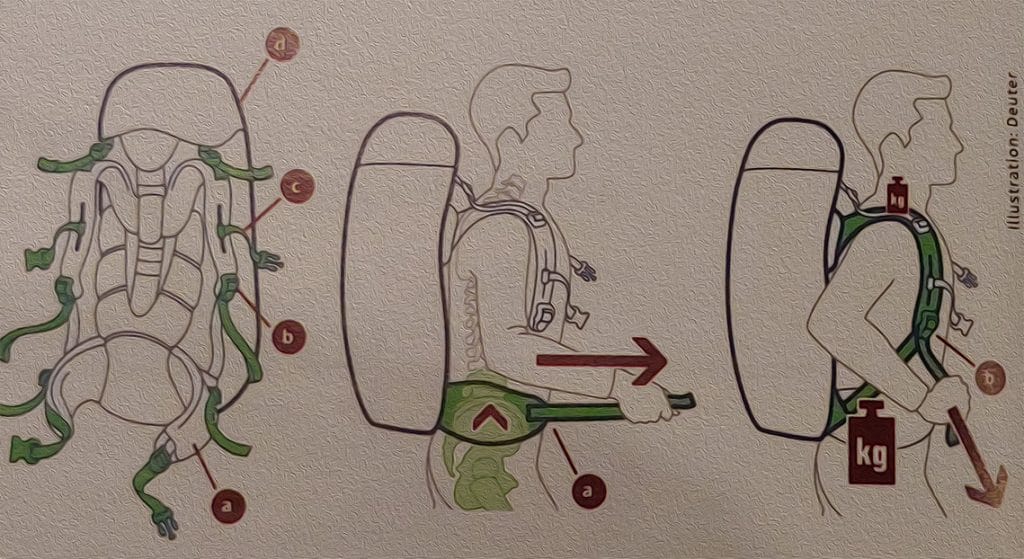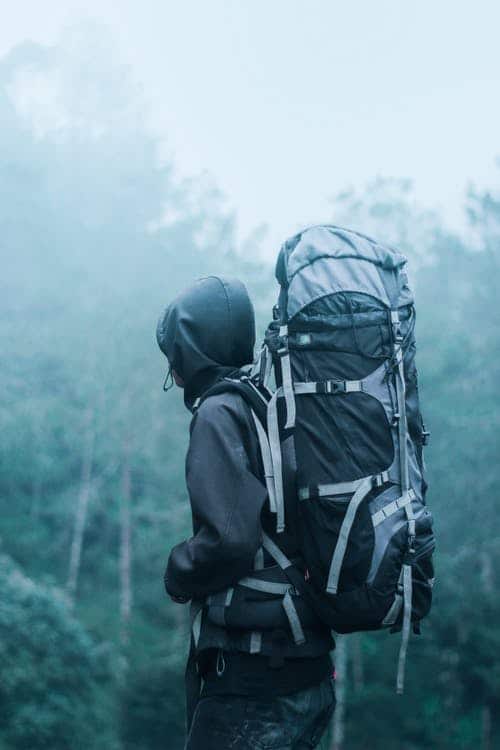Table of Contents
No matter if you go hiking or mountaineering, if you’re on a multi-day hike, there is no way around a heavy backpack. All the things you need to set up camp like a sleeping bag, cooking gear, your tent plus freshwater and food are heavy. And in most cases, your lower back is the crucial part carrying the weight. You don’t need to be especially prone to back issues to profit from these tips on how to avoid hiking backpack back pain. This guide is battle proven and backed by science, so read on for the details!
An ergonomic backpack and some simple rules will lay the base to avoid hiking backpack back pain. This post will be split into multiple parts:
Bio Mechanical Basics: Your Back in Easy Words Explained
Your back consists of the sacrum, and the sacroiliac joint (SIJ), which connects to the spine. The SIJ connects the Sacrum and spine to each other, and as thus it connects back and leg muscles and transfers loads to your legs. This joint is particularly important if you carry a heavy backpack on a hike. In fact, it constantly moves when you walk around with your backpack, and that’s why a blockage in the SIJ causes back pain. Source article found here.
How Back Pain Is Caused When You Hike With a Heavy Backpack on Your Back
On a hike there are some situation that lead to blockage and then back pain: If you step into air because you miss a step or rock, or if you stumble, these things frequently lead to misplaced loads and then blockage of the SIJ. But chronic distress during your normal workday lead to back pain as well. Long static sitting at work, wrong movement when you carry loads, etc. can lead to blockage. Even if you don’t feel any pain in normal life, under load of a back pack these issue pop up.
A heavy backpack causes back pain when weight is placed on your joints in the wrong way. The basics are simple: You want a heavy weight to be evenly distributed on upper and lower body. A backpack has shoulder straps and a waist band. The shoulder straps transfer to the shoulder, the waistband to the legs, via the back. The weight which is transferred to the legs can be transferred through the sacrum or the pelvic bone. Any weight transferred to shoulders will go directly down the line to your SIJ and then the leg muscles.
The SIJ connects your back with the the legs via the sacrum, and any load placed on it directly will be transferred via the sacrum to the leg muscles. But the SIJ is particularly sensitive to displacement of the moment of inertia of loads, as are most joints. In some ways, the SIJ is similar to the conical grinder of a coffee machine: If you place a load on top of it and move it, it cannot move freely, as the gap for free movement reduces.reduced. The consequence is back pain.
Reduce Back Pain by Reducing Weight Placed on the SIJ and Sacrum
Your goal should be to reduce the load to the SIJ. If you want to do this, you have only one option: Put more load on the pelvic bones or waist. Don’t let the shoulder straps fool you: The weight that you place on your shoulders transfer down to your sacrum and SIJ more ore less directly, bio mechanically speaking. It follows the shortest route, and that’s a straight line directly down to your Sacrum. If you ever wondered why your lower back hurts when you wear a backpack without waist band / hip belt, this is the reason. But how to reduce the load on the SIJ? You have two ways that complement each other nicely.
A) Use a Waist Band / Hip Belt to Transfer Load Directly to Your Pelvic Bones and Then Legs
A carrying system that’s useful from a biomechanical viewpoint is reducing load on the shoulders and instead places it on the pelvic bones. This makes sure the weight is directly transferred to the leg muscles, without stressing the SIJ and Sacrum. As a consequence, the Sacrum is not displaced, and the gap between SIJ and Sacrum is nice and wide. This ensures free movement and no grinding (remember the coffee grinder!). To put the weight on the pelvic bone, carrying systems have a waist band / hip belt. This band ideally sits tight on your body, and if you adjust it correctly, the transmission of weight on the pelvical bone relieves the SIJ a lot. You can even have more than half of weight going directly to your legs this way!
B) Pack Your Backpack Right, I.E. With the Centroid Placed Correctly
Another way to reduce load on the SIJ is to pack the backpack right. A backpack that is packed correctly needs to have the centroid as close to your body as possible. If it does, then as much as 70% of the weight can be transferred to your legs directly via the pelvic bone, and only 30% are transferred via the shoulders and SIJ. Obviously, you cannot reduce the amount of weight transferred via shoulders to 0% as you always need them for stability and balance. Follow these tips to ensure the centroid of the backpack sits nice and tight to your body:
- Put light items to the ground, heavy items as close to the body as possible, less heavy stuff further away from your body
- Light terrain hiking: Centroid of weight close to body and at height of the shoulders
- Difficult terrain hiking: Centroid a little below the shoulders, to give more stability when going steep downhill and climbing
- Use side pockets to evenly distribute the weight on left and right side
How to Adjust Your Backpack to Reduce Hiking Backpack Back Pain
If you want to adjust your backpack, you first need a good carrying system. So my first advice is to buy a quality backpack. There are many good brands including Vaude, Lowa and Osprey to name a few. If you buy a backpack, pay some attention that the backpack fits your anatomy. What this means: Width of shoulder straps, shape of the waist band / hip belt, length of back piece and length adjustment of the carrying system. You should also pack the backpack with realistic weight, aka if you try it on in the store, bring some gear to stuff, and make sure to loosen all the straps BEFORE trying.
For adjusting the hiking backpack correctly to avoid back pain when hiking, follow this easy to remember sequence:
A) Adjust the waist band / hip belt first, place it on the middle of the pelvic bone on an area known as the iliac crest.
B) Adjust shoulder straps: Carrier inserts should be at height of your blade bone. Don’t make the classic mistake of pulling the straps too tight, as this moves the weight too much over the shoulders and away from your pelvic bone where you want it.
C) Adjust chest strap: Its used to keep the shoulder straps in position.
D) Adjust the angle and stability of the load via the load adjuster straps.

Once you have all these adjusted, you are ready to go.
Use Sticks to Avoid Back Pain Both Ascending and Descending
No matter how good your carrying system is and how much care you pay while packing the backpack, if you have a heavy backpack your centroid is shifted backwards. Your bodys natural reaction is to lean forward while walking, which puts you in a bio mechanically problematic posture due to reduced freedom of movement in your SIJ and will lead to back pain in the long run. Ascending only makes this worse.
If you know how to use them, sticks are a great way to reduce the forward leaning while ascending and walking on a plain surface, and also help while descending. Sticks also help you to transfer weight force directly via your arms to the ground, relieving your SIJ. For most hikers they will also be really comfortable as they reduce load on the leg muscles and help utilizing arms while ascending. This leads to more even distribution of stress, and lets you hike longer and with less fatigue on individual muscle groups.
Sticks are also a great way to reduce load on knee and leg joints while descending. They also help you maintain upright posture when descending. Without sticks, many hikers tend to lean backwards while descending, which leads to an unnatural foot position where the heel is absorbing most of the load. This load is then transferred into the SIJ which in turn leads to even more back pain. Sticks reduce this, as they help you maintain an upright ad stable position, where you can naturally roll your feet while descending.
Conclusion
If you want to avoid back pain from your backpack while hiking, make sure to adjust your backpack correctly. Most back pain from heavy backpacks is caused by incorrect load transfer to the SIJ and Sacrum. A properly adjusted backpack transfers as much as 70% of the weight directly to the leg muscles via the pelvic bones, reducing load on the SIJ and Sacrum, and if you follow the steps above you can adjust it yourself easily. If you liked this post, feel free to leave a comment and read on some of your other gear related posts!

